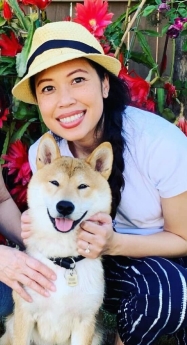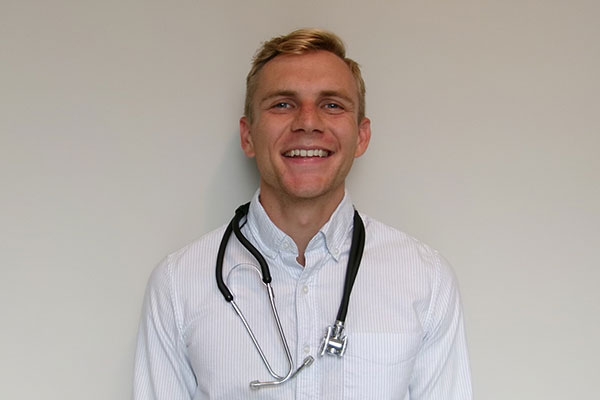For Vivian Dao-Tong, the importance of clinical research and its positive effects on health are personal.
One of her family members participated in a clinical trial for diabetes research and Vivian was taken aback at how much care and attention they received from the trial staff during each monthly visit. “The research team was very knowledgeable and resourceful. They spent a lot of time explaining to us what diabetes was and how to modify lifestyle habits to help improve quality of life,” Vivian explains.
“When the clinical trial was over and the drug went to market, it was neat to see how my family member’s participation in the clinical trial played a huge role in helping other patients have access to a new therapy to help manage their diabetes.”
This experience stuck with her. It’s what led her to earn a B.S. in biological sciences (with a minor in psychology) from Sacramento State and then to continue her education in the field with an M.S. in pharmaceutical sciences from Touro University.
In the field, Vivian has held clinical research coordinator and clinical research associate roles at various biotech companies in the Bay Area. It was during these experiences when Vivian realized that in order to succeed and help others improve their quality of life, she would need the technical know-how to effectively oversee a clinical trial from start to finish.
“The Bay Area is home to a lot of biotech companies and unfortunately not all companies will teach their employees on how to lead and manage a clinical trial,” Vivian explains.
“It was important for me to find a program that would prepare me to be knowledgeable in FDA and ICH Good Clinical Practices regulations and understand best practices on how to start, maintain and close out a clinical trial.”
So Vivian turned to some coworkers for advice, many of whom had excelled in their careers after completing our Certificate Program in Clinical Research Conduct and Management. With those recommendations in mind, Vivian knew that our certificate would be the perfect path toward career success.
“I was also drawn to UC Berkeley Extension’s reputation of upholding rigorous academic standards that would prepare me for my career in clinical trials.”
In August 2019, Vivian took her first step in investing in her future: Enrolling in the Introduction to Clinical Research: Clinical Trial Phases and Design course.

It was important for me to find a program that would prepare me to be knowledgeable in FDA and ICH Good Clinical Practices regulations and understand best practices on how to start, maintain and close out a clinical trial. I was also drawn to UC Berkeley Extension’s reputation of upholding rigorous academic standards that would prepare me for my career in clinical trials.
You took all of the classes online. Tell me about your experience going through the certificate.
I really enjoyed meeting other students and instructors virtually. The teachers really cared for their students and shared their industry experiences with us.
Assignments were applicable to day-to-day operations in the field. I remember we had an assignment where we had to write out what to prepare prior to conducting a monitoring visit.
I really enjoyed the flexibility of taking online classes because I was also working full time as a clinical trials specialist at Exelixis.
The curriculum was very logical. The first course was very high-level and challenging, but as I navigated through the program, it started to get easier. I enjoyed learning about the different life cycles of a clinical trial—such as startup, maintenance, close-out, post-market—different phases of a clinical trial and inspection readiness.
I really enjoyed the flexibility of taking online classes because I was also working full time as a clinical trials specialist at Exelixis.
Since completing the certificate, you’ve moved up from a clinical trials specialist to a clinical trials manager.
Yes, I am working at Alector, a biotechnology company in South San Francisco that focuses on neurodegenerative and immuno-neurology therapies.
Some of my day-to-day responsibilities include:
Ensuring sponsor oversight by managing contract research organizations (CROs) and study vendors
Overseeing regional site management activities
Performing data listing reconciliations and protocol-deviation reviews.
Managing CTA and budget negotiations
Leading study document reviews with cross-functional team members
Overseeing Trial Master File (TMF) as part of inspection readiness
Identifying risks and performing mitigation
Working on clinical-development operations, process, initiatives and improvement
That’s quite a lot of responsibilities! Are you incorporating lessons learned from the certificate to your work?
Absolutely! There was one company that I worked for that was a pre-IPO biotech company. At the time, the company wanted to start a clinical trial but did not know how or what guidelines to follow. I was able to explain what processes must be in place before starting a clinical trial—such as site feasibility, site qualification, site selection, et cetera—and worked very closely with the project manager to set realistic timelines.
This program provided me with a lot of knowledge and gave me the tools to be resourceful so that I can help lead my team to manage a clinical trial successfully.
What does earning this certificate mean to you personally and professionally?
With the constant changes in the world, there are so many new and undiscovered illnesses out there. Being able to research these emerging illnesses and investing the time, effort and money to run these clinical trials is very rewarding. Not everyone can say that they can put a drug out on the market, and for me it is an ultimate career goal to be a part of a team that is able to do this.
This program provided me with a lot of knowledge and gave me the tools to be resourceful so that I can help lead my team to manage a clinical trial successfully.
What advice would you give to a student who is starting the certificate?
Stay organized and stay disciplined! Don't be afraid to ask questions if you do not understand the material at first.



